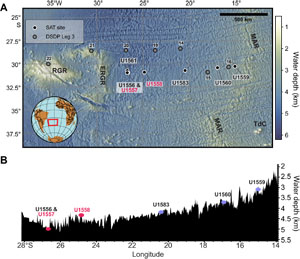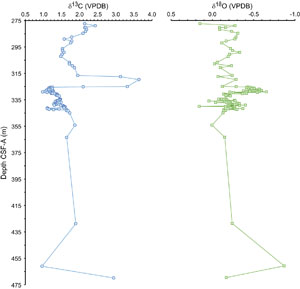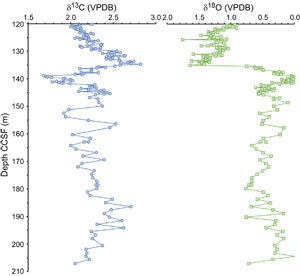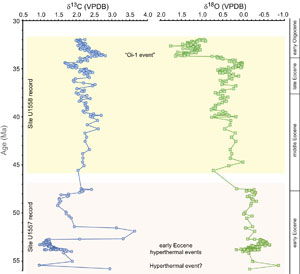Coggon, R.M., Teagle, D.A.H., Sylvan, J.B., Reece, J., Estes, E.R., Williams, T.J., Christeson, G.L., and the Expedition 390/393 Scientists
Proceedings of the International Ocean Discovery Program Volume 390/393
publications.iodp.org
https://doi.org/10.14379/iodp.proc.390393.208.2024
Data report: early Eocene–early Oligocene carbon and oxygen stable isotope data of bulk carbonates, IODP Expedition 390/393 Sites U1557 and U1558, South Atlantic Transect1
Chiara Borrelli,2 Christopher M. Lowery,2 Andrew McIntyre,2 Claire M. Routledge,2 Trevor J. Williams,2 and the Expedition 390/393 Scientists2
1 Borrelli, C., Lowery, C.M., McIntyre, A., Routledge, C.M., Williams, T.J., and the Expedition 390/393 Scientists, 2024. Data report: early Eocene–early Oligocene carbon and oxygen stable isotope data of bulk carbonates, IODP Expedition 390/393 Sites U1557 and U1558, South Atlantic Transect. In Coggon, R.M., Teagle, D.A.H., Sylvan, J.B., Reece, J., Estes, E.R., Williams, T.J., Christeson, G.L., and the Expedition 390/393 Scientists, South Atlantic Transect. Proceedings of the International Ocean Discovery Program, 390/393: College Station, TX (International Ocean Discovery Program). https://doi.org/10.14379/iodp.proc.390393.208.2024
2 Expedition 390/393 Scientists’ affiliations. Correspondence author: cborrelli@ur.rochester.edu
Abstract
During International Ocean Discovery Program Expeditions 390C, 395E, 390, and 393 (the South Atlantic Transect), seven sites were drilled on the western flank of the southern Mid-Atlantic Ridge. Among these sites, Sites U1557 and U1558 recovered Eocene and Oligocene sediments. Such sediments will allow a better understanding of how ocean ecosystems, as well as ocean circulation and chemistry, responded to the paleoceanographic and paleoclimatic changes leading to the Eocene–Oligocene transition. In this study, we present early Eocene through early Oligocene carbon and oxygen stable isotope data (δ13C and δ18O) of bulk carbonates from sediment samples collected in Holes U1557B, U1558A, and U1558F. The data show that the western South Atlantic, a relatively understudied region for the Eocene, recorded some global geochemical features, such as the relatively low δ13C and δ18O values typical of hyperthermal events characterizing the onset of the Early Eocene Climatic Optimum and the rapid shift toward high δ18O and δ13C values at the Eocene/Oligocene boundary.
1. Introduction
The South Atlantic Transect (SAT) comprises a series of sites along the western flank of the southern Mid-Atlantic Ridge (~31°S) cored during International Ocean Discovery Program (IODP) engineering Expeditions 390C and 395E and Expeditions 390 and 393 conducted between October 2020 and August 2022 (Estes et al., 2021; Williams et al., 2021; Coggon et al., 2022; Teagle et al., 2023). This region was previously spot cored between December 1968 and January 1969 during Deep Sea Drilling Project Leg 3 (Maxwell et al., 1970) and had not been revisited since.
Seven sites were drilled along the SAT on crust ranging around 61 Ma. These new cores offer the opportunity to investigate the evolution of a bipolar ocean circulation in connection with the opening of the Drake Passage and the history of the deep western boundary current, changes in carbonate surface productivity and carbonate burial in the western South Atlantic throughout the Cenozoic, and the development of a modern-like subtropical gyre and its impact on planktonic assemblages.
During the Eocene (~56–33.9 Ma), Earth transitioned from a climate characterized by high temperatures and the absence of permanent ice sheets to a climate characterized by cooler temperatures, lower atmospheric CO2 concentrations, and the build-up of permanent ice sheets on Antarctica at the Eocene–Oligocene transition, with possible episodic Northern Hemisphere glaciations, as well (i.e., hothouse–coolhouse transition; Westerhold et al., 2020) (e.g., Zachos et al., 2001; Cramer et al., 2011; Anagnostou et al., 2016; Tripati and Darby, 2018; Miller et al., 2020).
Sediments recovered at Site U1557 during engineering Expedition 390C (October–December 2020) and Site U1558 during engineering Expedition 390C and Expedition 393 (June–August 2022) (Coggon et al., 2024a; Teagle et al., 2024) are promising archives of ocean circulation and chemistry changes during the Eocene and Oligocene. Here, we report carbon and oxygen stable isotope data (δ13C and δ18O) of bulk carbonates from sediment samples collected at these sites. Data were combined to build a stable isotope curve spanning the entire Eocene and early Oligocene. These data can be used to refine the age models at Sites U1557 and U1558 and for chemostratigraphic correlation with sites located in the Atlantic and other ocean basins. This data set could also facilitate further sampling efforts of cores from these sites for high-resolution paleoceanography-relevant Eocene research.
2. Methods and materials
2.1. Site description
Site U1557 (30°56.4547′S, 26°37.7775′W; Figure F1) is located in a downthrown fault-bounded basin ~1250 km west of the Mid-Atlantic Ridge, at a water depth of 5012 m (Coggon et al., 2024b). This site is located on oceanic crust of ~61 Ma and, together with Sites U1556 and U1561, is one of the oldest sites drilled along the SAT. For this study, we utilized cores collected from Hole U1557B (Cores 31X–51X; 277.38–469.86 m core depth below seafloor, Method A [CSF-A]). This hole was drilled during engineering Expedition 390C (Estes et al., 2021), but the cores were described during Expedition 390 (Coggon et al., 2024b). The cores analyzed for this study were cored using the extended core barrel (XCB) system, and recovery was 31%–95%. Sediments in the Eocene/early Oligocene study interval are mostly composed of nannofossil and/or calcareous chalk (Coggon et al., 2024a).
Site U1558 (30°53.7814′S, 24°50.4822′W; Figure F1) is located ~1067 km west of the Mid-Atlantic Ridge, at a water depth of 4337 m (Estes et al., 2021; Coggon et al., 2024b). It sits on oceanic crust of ~49 Ma. For this study, we measured samples collected from Holes U1558A (Cores 12X–18X; 121.54–190.20 m core composite depth below seafloor [CCSF]) and U1558F (Cores 12F–24X; 120.22–207.10 m CCSF). Hole U1558A was drilled during engineering Expedition 390C; the cores analyzed here were cored with the XCB system and recovery varied between 58% and 80% (Estes et al., 2021). Hole U1558F was drilled during Expedition 393. Cores 12F–19F were cored using the half-length advanced piston corer (HLAPC) system, which resulted in significantly better recovery, whereas Cores 20X–24X were XCB cored. Overall, recovery for the cores used in this study ranged 77%–109% (Coggon et al., 2024b). The sediment analyzed consists of nannofossil ooze/chalk with clay (Teagle et al., 2024).
2.2. Sample preparation and stable isotope analyses
We analyzed a total of 250 sediment samples from Holes U1557B (n = 96), U1558A (n = 57), and U1558F (n = 97). Sampling resolution was driven by the goal to obtain a (relatively) high resolution record for the early Eocene hyperthermals (~54–52 Ma) and the late Eocene through early Oligocene interval (~34.5–32 Ma) and a lower resolution record for the rest of the Eocene. Core sampling was guided by the preliminary age models for these sites (Coggon et al., 2024a; Teagle et al., 2024) and the need to accommodate for core gaps or disturbances. Sampling resolution ranged ~20 cm to several meters.
Samples were prepared for analysis at the University of Rochester (USA). Samples were dried overnight at 50°C and homogenized afterward by grinding a small aliquot of sediment with a mortar and pestle. Bulk δ13C and δ18O were measured using a Nu Carb device attached to a Nu Instruments Perspective isotope ratio–mass spectrometer (IR-MS) at the Department of Earth and Planetary Sciences at Rutgers University (USA). Samples were reacted in phosphoric acid at 70°C, and the evolved CO2 was collected in a liquid nitrogen cold finger. Stable isotope values were reported relative to Vienna Peedee belemnite (VPDB) through the analysis of an in-house laboratory reference material (RGF1). The 1σ standard deviation of RGF1 made during daily runs (typically 8 RGF1 analyses for every 24 samples) was 0.03‰ (δ13C) and 0.06‰ (δ18O). RGF1 is routinely calibrated to NBS-19 to ensure consistency using 1.95‰ for δ13C and −2.20‰ for δ18O, as reported by Coplen (1994). The internal laboratory reference material differs from NBS-19 by +0.10‰ for δ13C and +0.04‰ for δ18O. The laboratory analyzes NBS-18 to monitor for changes in source linearity for δ18O for comparison to the value of 23.01‰ reported by Coplen (1994).
Data are displayed against depth; the CSF-A scale is used for Site U1557, which does not have a splice (Figure F2), and the CCSF scale is used for Site U1558 (Figure F3). For Site U1558, the CCSF depth scale was calculated using the shipboard correlator’s affine table. Data are also displayed against age (Figure F4). Sample ages were calculated based on the preliminary age models for these sites (Coggon et al., 2024a; Teagle et al., 2024). For Site U1558, we used the Hole U1558F age model to calculate sample ages along the splice because it is better constrained than the age model for Hole U1558A.
3. Results
3.1. Bulk carbon stable isotopes
At Site U1557, δ13C values range ~1‰–3.64‰ from the early to early middle Eocene (Figures F2, F4). The lower part of the record (470–345 m CSF-A) indicates a shift in δ13C from 2.94‰ to ~1.73‰. In particular, a negative shift from 2.94‰ to 0.96‰ is recorded in two samples between ~470 and 460 m CSF-A and occurs in the earliest Eocene (Figure F4). The Paleocene/Eocene Thermal Maximum (PETM) was identified at Site U1557 based on the occurrence of the calcareous nannoplankton excursion taxon Rhomboaster spp., one of the classic PETM markers (Bown, 2005), at 461.33 m CSF-A in a ~50 cm thick dark red pelagic clay that was not sampled for this data report (Coggon et al., 2024a). Therefore, this initial negative isotope excursion is likely one of the earliest Eocene hyperthermal events, but more detailed chemostratigraphic and biostratigraphic analyses are required to properly confirm this hypothesis. Average δ13C values ~1.4‰ characterizes the record from 345 to 325 m CSF-A and are tentatively interpreted as the carbon isotope excursions of the hyperthermal events (Galeotti et al., 2010; Kirtland Turner et al., 2014) characterizing the onset of the Early Eocene Climatic Optimum (~54–48.2 Ma) (Westerhold et al., 2018). This interpretation agrees with the shipboard age model for this site (Figure F4) (Coggon et al., 2024a). Between ~325 and 315 m CSF-A, the record shows a well-constrained positive excursion in δ13C (with values as high as ~3.6‰ and as low as ~2‰), which is followed by values from ~1.7‰ to 2‰ toward the upper part of the section (315–277 m CSF-A).
At Site U1558, δ13C values range ~1.7‰–2.8‰ (Figure F3). In the lower part of the record (207–157 m CCSF), values vary between 2‰ and 2.7‰. A well-constrained δ13C shift from ~1.9‰ to ~2.6‰ is recorded by samples located between 140 and 135 m CCSF and accompanies the increase in δ18O values that we interpret as the Eocene/Oligocene boundary (see below). A steady decrease to ~2‰ is shown in the upper analyzed sediments (~134–120 m CCSF). According to the shipboard age model (Teagle et al., 2024), the Site U1558 samples measured are of middle Eocene–early Oligocene age (Figure F4).
3.2. Bulk oxygen stable isotopes
At Site U1557, δ18O values range ~0.2‰ to approximately −0.9‰ (Figures F2, F4). The lower part of the record (470–460 m CSF-A) shows a negative shift in δ18O of ~0.7‰, which supports the possibility of this part of the record recording a hyperthermal event. This negative excursion is followed by a partial recovery to approximately −0.2‰. Values ranging ~0.2 to −0.7‰ characterize the rest of the samples analyzed (354–277 m CSF-A). A transient shift of ~0.2‰ toward slightly more negative values (345–325 m CSF-A) supports the preliminary interpretation of this interval capturing some the early Eocene hyperthermals (cf. Kirtland Turner et al., 2014).
At Site U1558, δ18O values range ~1.8‰–0‰ (Figures F3, F4). From 207 to 140 m CCSF, δ18O oscillates between 0‰ and ~0.8‰. A large shift of ~1.6‰ toward more positive values is recorded by samples located between ~140 and ~135 m CCSF. Based on the similarity of this signal with other bulk carbonate δ18O records (e.g., Shackleton, 1986) and the preliminary age model for this site (Teagle et al., 2024), this shift is interpreted as the global Eocene/Oligocene increase in δ18O (Oi-1 event; e.g., Miller et al., 1991). Values slowly decrease to ~1‰ in the upper samples analyzed (135–120 m CCSF).
4. Data availability
Stable isotope data are included here in Table T1 and permanently archived at PANGAEA (https://doi.pangaea.de/10.1594/PANGAEA.964943 and https://doi.pangaea.de/10.1594/
5. Acknowledgments
We thank Richard Mortlock and Jim Wright (Rutgers University) for their assistance with stable isotope analysis and Lily Matt (University of Rochester) for her assistance with sample preparation. We are indebted to the drillers, technicians, and crew of JOIDES Resolution, without whom we would not have any cores to analyze, as well as the staff of the Bremen Core Repository, who assisted with sample collection. We are also grateful to Kirsty Edgar for her very constructive comments on an early version of the manuscript. This research was supported by a postcruise activity award from the IODP U.S. Science Support Program (National Science Foundation prime award OCE1450528) to C. Borrelli.
References
Anagnostou, E., John, E.H., Edgar, K.M., Foster, G.L., Ridgwell, A., Inglis, G.N., Pancost, R.D., Lunt, D.J., and Pearson, P.N., 2016. Changing atmospheric CO2 concentration was the primary driver of early Cenozoic climate. Nature, 533(7603):380–384. https://doi.org/10.1038/nature17423
Bown, P.R., 2005. Palaeogene calcareous microfossils from the Kilwa and Lindi areas of coastal Tanzania (Tanzania Drilling Project 2003–4). Journal of Nannoplankton Research, 27:21–95.
Coggon, R.M., Sylvan, J.B., Teagle, D.A.H., Reece J., Christeson, G.L., Estes, E.R., Williams, T.J., and the Expedition 390 Scientists, 2022. Expedition 390 Preliminary Report: South Atlantic Transect 1. International Ocean Discovery Program. https://doi.org/10.14379/iodp.pr.390.2022
Coggon, R.M., Sylvan, J.B., Estes, E.R., Teagle, D.A.H., Reece, J., Williams, T.J., Christeson, G.L., Aizawa, M., Borrelli, C., Bridges, J.D., Carter, E.J., Dinarès-Turell, J., Estep, J.D., Gilhooly, W.P., III, Grant, L.C.J., Kaplan, M.R., Kempton, P.D., Lowery, C.M., McIntyre, A., Routledge, C.M., Slagle, A.L., Takada, M., Tamborrino, L., Wang, Y., Yang, K., Albers, E., Amadori, C., Belgrano, T.M., D’Angelo, T., Doi, N., Evans, A., Guérin, G.M., Harris, M., Hojnacki, V.M., Hong, G., Jin, X., Jonnalagadda, M., Kuwano, D., Labonte, J.M., Lam, A.R., Latas, M., Lu, W., Moal-Darrigade, P., Pekar, S.F., Robustelli Test, C., Ryan, J.G., Santiago Ramos, D., Shchepetkina, A., Villa, A., Wee, S.Y., Widlansky, S.J., Kurz, W., Prakasam, M., Tian, L., Yu, T., and Zhang, G., 2024a. Site U1557. In Coggon, R.M., Teagle, D.A.H., Sylvan, J.B., Reece, J., Estes, E.R., Williams, T.J., Christeson, G.L., and the Expedition 390/393 Scientists, South Atlantic Transect. Proceedings of the International Ocean Discovery Program, 390/393: College Station, TX (International Ocean Discovery Program). https://doi.org/10.14379/iodp.proc.390393.105.2024
Coggon, R.M., Teagle, D.A.H., Sylvan, J.B., Reece, J., Estes, E.R., Williams, T.J., Christeson, G.L., Aizawa, M., Albers, E., Amadori, C., Belgrano, T.M., Borrelli, C., Bridges, J.D., Carter, E.J., D'Angelo, T., Dinarès-Turell, J., Doi, N., Estep, J.D., Evans, A., Gilhooly, W.P., III, Grant, L.J.C., Guérin, G.M., Harris, M., Hojnacki, V.M., Hong, G., Jin, X., Jonnalagadda, M., Kaplan, M.R., Kempton, P.D., Kuwano, D., Labonte, J.M., Lam, A.R., Latas, M., Lowery, C.M., Lu, W., McIntyre, A., Moal-Darrigade, P., Pekar, S.F., Robustelli Test, C., Routledge, C.M., Ryan, J.G., Santiago Ramos, D., Shchepetkina, A., Slagle, A.L., Takada, M., Tamborrino, L., Villa, A., Wang, Y., Wee, S.Y., Widlansky, S.J., Yang, K., Kurz, W., Prakasam, M., Tian, L., Yu, T., and Zhang, G., 2024b. Expedition 390/393 summary. In Coggon, R.M., Teagle, D.A.H., Sylvan, J.B., Reece, J., Estes, E.R., Williams, T.J., Christeson, G.L., and the Expedition 390/393 Scientists, South Atlantic Transect. Proceedings of the International Ocean Discovery Program, 390/393: College Station, TX (International Ocean Discovery Program). https://doi.org/10.14379/iodp.proc.390393.101.2024
Coplen, T.B., 1994. Reporting of stable hydrogen, carbon, and oxygen isotopic abundances. Pure and Applied Chemistry, 66(2):273–276. https://doi.org/10.1351/pac199466020273
Cramer, B.S., Miller, K.G., Barrett, P.J., and Wright, J.D., 2011. Late Cretaceous–Neogene trends in deep ocean temperature and continental ice volume: reconciling records of benthic foraminiferal geochemistry (δ18O and Mg/Ca) with sea level history. Journal of Geophysical Research: Oceans, 116(C12):C12023. https://doi.org/10.1029/2011JC007255
Estes, E.R., Williams, T., Midgley, S., Coggon, R.M., Sylvan, J.B., Christeson, G.L., and Teagle, D.A.H., 2021. Expedition 390C Preliminary Report: South Atlantic Transect Reentry Systems. International Ocean Discovery Program. https://doi.org/10.14379/iodp.pr.390C.2021
Galeotti, S., Krishnan, S., Pagani, M., Lanci, L., Gaudio, A., Zachos, J.C., Monechi, S., Morelli, G., and Lourens, L., 2010. Orbital chronology of Early Eocene hyperthermals from the Contessa Road section, central Italy. Earth and Planetary Science Letters, 290(1–2):192–200. https://doi.org/10.1016/j.epsl.2009.12.021
Gradstein, F.M., Ogg, J.G., Schmitz, M.D., and Ogg, G.M. (Eds.), 2020. The Geologic Time Scale 2020: Amsterdam (Elsevier BV). https://doi.org/10.1016/C2020-1-02369-3
Kirtland Turner, S., Sexton, P.F., Charles, C.D., and Norris, R.D., 2014. Persistence of carbon release events through the peak of early Eocene global warmth. Nature Geoscience, 7(10):748–751. https://doi.org/10.1038/ngeo2240
Maxwell, A.E., Von Herzen, R.P., Andrews, J.E., Boyce, R.E., Milow, E.D., Hsu, K.J., Percival, S.F., and Saito, T., 1970. Initial Reports of the Deep Sea Drilling Project, 3: Washington, DC (U.S. Government Printing Office). https://doi.org/10.2973/dsdp.proc.3.1970
Miller, K.G., Browning, J.V., Schmelz, W.J., Kopp, R.E., Mountain, G.S., and Wright, J.D., 2020. Cenozoic sea-level and cryospheric evolution from deep-sea geochemical and continental margin records. Science Advances, 6(20):eaaz1346. https://doi.org/10.1126/sciadv.aaz1346
Miller, K.G., Wright, J.D., and Fairbanks, R.G., 1991. Unlocking the Ice House: Oligocene-Miocene oxygen isotopes, eustasy, and margin erosion. Journal of Geophysical Research: Solid Earth, 96(B4):6829–6848. https://doi.org/10.1029/90JB02015
Reece, R., and Estep, J., 2019. Processed MCS (PSTM) data from the Mid-Atlantic Ridge (MAR) to the Rio Grande Rise, South Atlantic Ocean, acquired by the R/V Marcus G. Langseth in 2016 (MGL1601) https://doi.org/10.1594/IEDA/500255
Ryan, W.B.F., Carbotte, S.M., Coplan, J.O., O’Hara, S., Melkonian, A., Arko, R., Weissel, R.A., Ferrini, V., Goodwillie, A., Nitsche, F., Bonczkowski, J., and Zemsky, R., 2009. Global multi-resolution topography synthesis. Geochemistry, Geophysics, Geosystems, 10(3):Q03014. https://doi.org/10.1029/2008GC002332
Shackleton, N.J., 1986. Paleogene stable isotope events. Palaeogeography, Palaeoclimatology, Palaeoecology, 57(1):91–102. https://doi.org/10.1016/0031-0182(86)90008-8
Teagle, D.A.H., Reece, J., Coggon, R.M., Sylvan, J.B., Christeson, G.L., Williams, T.J., Estes, E.R., and the Expedition 393 Scientists, 2023. Expedition 393 Preliminary Report: South Atlantic Transect 2. International Ocean Discovery Program. https://doi.org/10.14379/iodp.pr.393.2023
Teagle, D.A.H., Reece, J., Williams, T.J., Coggon, R.M., Sylvan, J.B., Estes, E.R., Christeson, G.L., Albers, E., Amadori, C., Belgrano, T.M., D’Angelo, T., Doi, N., Evans, A., Guérin, G.M., Harris, M., Hojnacki, V.M., Hong, G., Jin, X., Jonnalagadda, M., Kuwano, D., Labonte, J.M., Lam, A.R., Latas, M., Lu, W., Moal-Darrigade, P., Pekar, S.F., Robustelli Test, C., Ryan, J.G., Santiago Ramos, D., Shchepetkina, A., Villa, A., Wee, S.Y., Widlansky, S.J., Aizawa, M., Borrelli, C., Bridges, J.D., Carter, E.J., Dinarès-Turell, J., Estep, J.D., Gilhooly, W.P., III, Grant, L.C.J., Kaplan, M.R., Kempton, P.D., Lowery, C.M., McIntyre, A., Routledge, C.M., Slagle, A.L., Takada, M., Tamborrino, L., Wang, Y., Yang, K., Kurz, W., Prakasam, M., Tian, L., Yu, T., and Zhang, G., 2024. Site U1558. In Coggon, R.M., Teagle, D.A.H., Sylvan, J.B., Reece, J., Estes, E.R., Williams, T.J., Christeson, G.L., and the Expedition 390/393 Scientists, South Atlantic Transect. Proceedings of the International Ocean Discovery Program, 390/393: College Station, TX (International Ocean Discovery Program). https://doi.org/10.14379/iodp.proc.390393.106.2024
Tripati, A., and Darby, D., 2018. Evidence for ephemeral middle Eocene to early Oligocene Greenland glacial ice and pan-Arctic sea ice. Nature Communications, 9(1):1038. https://doi.org/10.1038/s41467-018-03180-5
Westerhold, T., Marwan, N., Drury, A.J., Liebrand, D., Agnini, C., Anagnostou, E., Barnet, J.S.K., Bohaty, S.M., De Vleeschouwer, D., Florindo, F., Frederichs, T., Hodell, D.A., Holbourn, A.E., Kroon, D., Lauretano, V., Littler, K., Lourens, L.J., Lyle, M., Pälike, H., Röhl, U., Tian, J., Wilkens, R.H., Wilson, P.A., and Zachos, J.C., 2020. An astronomically dated record of Earth’s climate and its predictability over the last 66 million years. Science, 369(6509):1383–1387. https://doi.org/10.1126/science.aba6853
Westerhold, T., Röhl, U., Donner, B., and Zachos, J.C., 2018. Global extent of Early Eocene hyperthermal events: a new Pacific benthic foraminiferal isotope record from Shatsky Rise (ODP Site 1209). Paleoceanography and Paleoclimatology, 33(6):626–642. https://doi.org/10.1029/2017PA003306
Williams, T., Estes, E.R., Rhinehart, B., Coggon, R.M., Sylvan, J.B., Christeson, G.L., and Teagle, D.A.H., 2021. Expedition 395E Preliminary Report: Complete South Atlantic Transect Reentry Systems. International Ocean Discovery Program. https://doi.org/10.14379/iodp.pr.395E.2021
Zachos, J., Pagani, M., Sloan, L., Thomas, E., and Billups, K., 2001. Trends, rhythms, and aberrations in global climate 65 Ma to Present. Science, 292(5517):686–693. https://doi.org/10.1126/science.1059412



